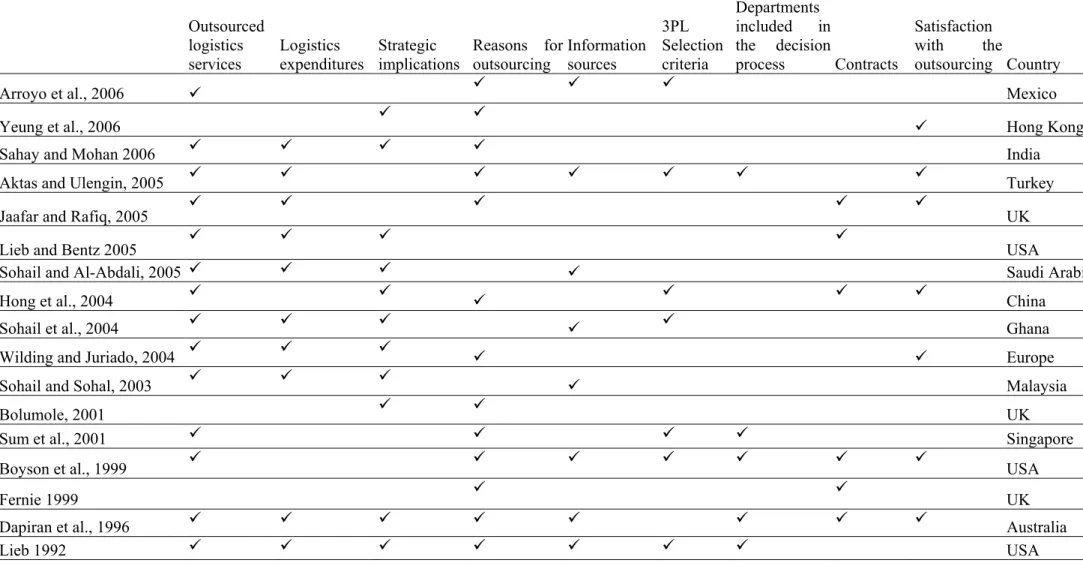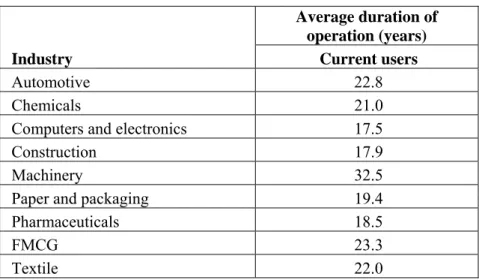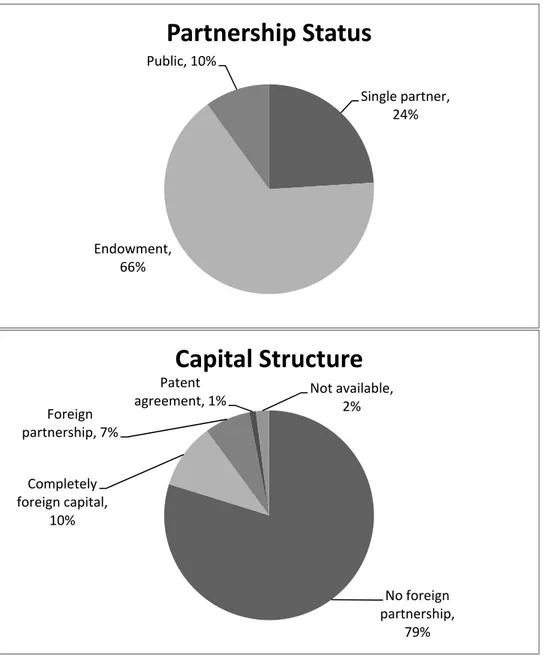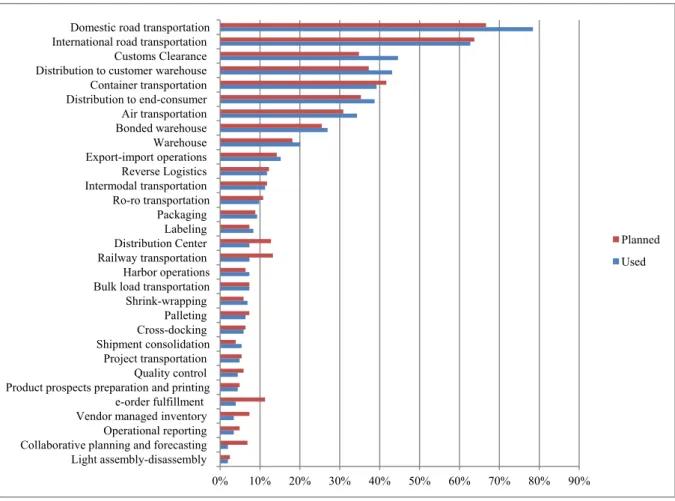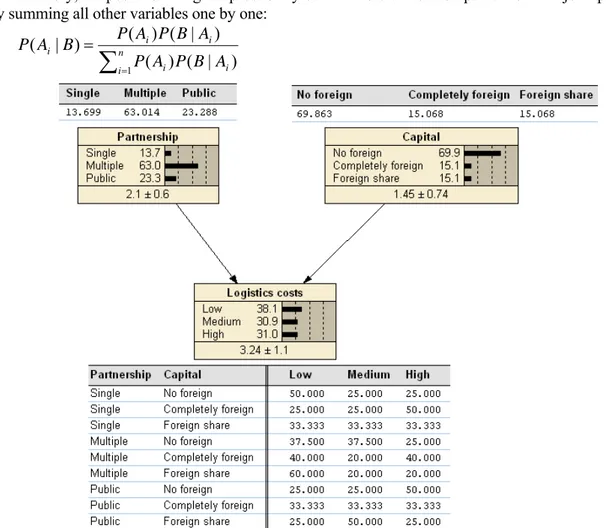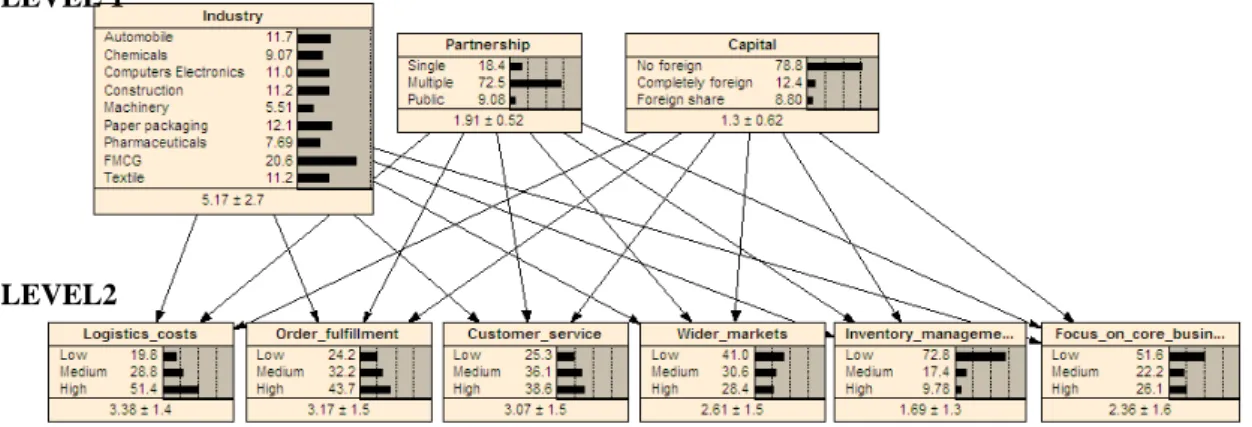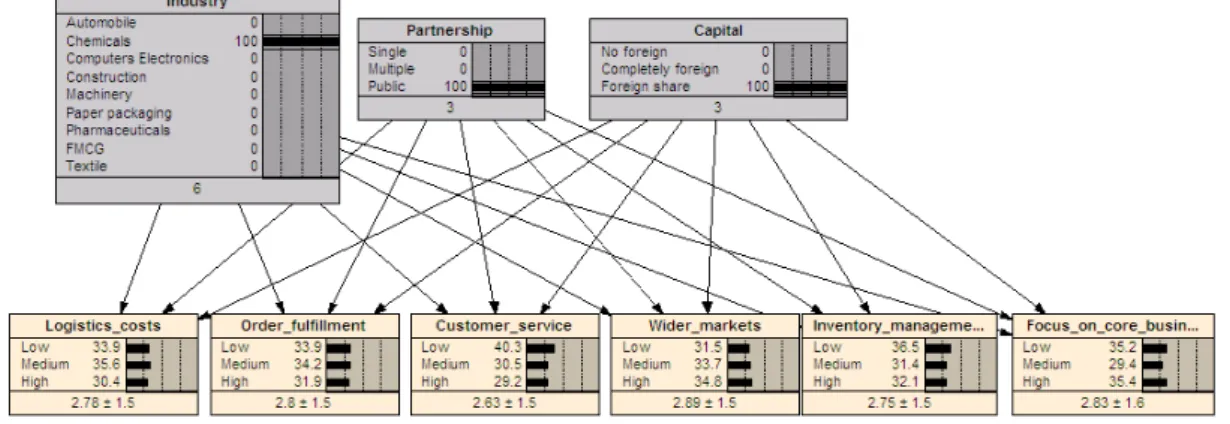WHAT TURKEY EXPECTS FROM LOGISTICS OUTSOURCING?
Berrin Agaran
1, Fusun Ulengin
2, Sule Onsel
3, Emel Aktas
4Abstract -
The economies of the world have become increasingly interdependent, and
organizations have come under tremendous pressure to maximize productivity and profitability.
Creating value through outsourcing has emerged as a popular competitive strategy for firms of
all sizes in all types of industries. The aim of this research is to investigate the use of third party
logistics in Turkish companies from the users’ perspective to identify
the types of logistics services outsourced, problems encountered in outsourcing these services, logistics costs, decision makers in outsourcing logistics activities, and information sources used in the decision-making process. A structured survey was selected as the tool for data collection. The field study involved face-to-face interviews with 204 companies out of top 500 companies ranked in terms of turnover that are registered with industrial associations and chambers of commerce in Turkey. Moreover, a decision support system based on Bayesian Causal Map is proposed for 3PLs in order to assist them in their service proposals for different sectors. This study is a first attempt to reveal and compare the outsourcing perception of the companies in different sectors, to expose the firms’ underlying motives as well as the respective importance of these motives for outsourcing logistics activities in Turkey. The use of Bayesian Causal Map based on the survey results provides an important guide to the 3PL providers to pick a suitable strategy and to prioritize their operational activities in different sectors in such a way to achieve a competitive advantage.Keywords: Outsourcing, Logistics, Structured-disguised survey, Decision Support for 3PLs,
Turkey
1. INTRODUCTION
An essential aspect of SCM is consistent, high-quality logistics services. As SCM becomes more sophisticated and the gap between what companies want to accomplish and what they can do in-house continues to grow, the rationale for outsourcing to third party logistics providers (3PLs) is further justified. Therefore, there is currently a trend among industrial firms of outsourcing those products and activities that are outside the company’s core business.
Previous research has shown that the decision to employ 3PLs is often restricted to the warehousing and transportation functions, which somewhat reduces the extent of the 3PLs’ impact on overall supply chain performance [1-3]. This raises key questions about the impact on supply chain effectiveness when the client organization motivated to outsource is different from the 3PL motivated to integrate logistics across the chain. To compete successfully, 3PLs may have to develop skills, competencies, and more value-added activities, which inevitably results in additional cost. Therefore, the main challenge for a 3PL provider is to pick a competitive strategy and prioritize their operational activities in such a way to achieve acceptable business performance. While substantive research has been done in the area of 3PL strategy and operational drivers, very little research has been conducted to address 3PL strategies and their operational priorities in relation to business performance [4]. In fact, if the customer segments vary in their logistics desires, it should be possible for 3PLs to customize logistics programs for different customer segments, which would improve both effectiveness and efficiency by not offering a one-service-fits-all type of offers. If, in contrast, customers view logistics services similarly across segments, and if that view consistently affects outcomes such as customer satisfaction in the same way across segments, 3PLs should be able to create logistics services that appear identical across customer segments, enabling them to leverage economies of scale. Therefore, 3PLs need to know the components that constitute logistics
1 Corresponding author. Berrin Agaran, Dogus University, Industrial Engineering Department, Acibadem, 34722,
Istanbul, Turkey, bagaran@dogus.edu.tr
2 Fusun Ulengin, Dogus University, Industrial Engineering Department, Acibadem, 34722, Istanbul, Turkey,
fulengin@dogus.edu.tr
3 Sule Onsel, Dogus University, Industrial Engineering Department, Acibadem, 34722, Istanbul, Turkey,
sonsel@dogus.edu.tr
service quality from the perspective of the customer. They should know what logistics service quality means to customers if they want to examine whether groups of customers place varying degrees of emphasis on specific aspects of this perspective.
This study analyzes the clients of 3PLs in Turkey using the results of a survey conducted in 2007. The reason of focusing on Turkey is that Turkey is accepted as an emergent market in the new millennium expected to attract the interest of global companies in their attempt to obtain competitive advantage. In recent years, in important international projects, such as TEN (Trans European Transport Network), TRACECA (Transport Corridor Europe-Caucasus-Asia) projects, Pan European Transport corridors (Corridors no 4, 8 and 10) Turkey has been placed over the international transport corridors, and takes part in the Trans European Transport System. From this perspective, Turkey, at the epicenter of transport corridors connecting Europe to the Caucasus and Asia as well as the Middle East, North Sea, and Balkan countries has a potential of becoming an important international logistics zone. This necessitates the realization of strategic plans to overcome logistics inefficiencies.
According to the findings of this study, 16% of the users had been using 3PL services, for one-to-five years, 17 % for five-to-ten years, and 67% reported using such services for more than ten years. Taking into account the fact that in India, 28.6 % of outsourcing companies have been using the services of third party logistics service providers for over three years and 18.8 % have been working with third party logistics service providers for 1-3 years, it can be said that Turkey has a relatively high amount of experience with third party logistics service providers [5].
The objectives of the research were:
1. To expose the firms’ underlying motives as well as the respective importance of these motives for outsourcing logistics activities.
2. To show the most frequently outsourced logistics services, the share of logistics costs in total and problems encountered in outsourcing partnerships.
3. To develop a model which can aid the 3PLs to build up strategies for offering their services
2. LITERATURE REVIEW
The logistics issue has witnessed an evolution from a passive cost-absorbing function to a strategic one which provides competitive advantage. 3PLs, which originally emerged out of companies that had previously been involved in warehousing and transportation, have extended their capabilities to involve a broad range of functions [6].
Despite recent rush in outsourcing service processes, its advantages and disadvantages brought to firms are increasingly debatable across industries [7]. Some studies show that outsourcing allows a firm to not only cut costs, but also focus on its core competences and help speed up its innovation processes [8]. In contrast, other research suggests that a firm that engages in outsourcing may lose control and flexibility, and potentially risk disclosure of proprietary knowledge to suppliers, who may become its competitors in the future [9]. While these contradictory viewpoints are equally appealing, yet no consensus is drawn in the literature as to the effect of outsourcing on firm performance. But the analysis of the literature shows that in order to get added-value from outsourcing, 3PLs should have a good understanding of what is required by what type of enterprise and develop strategies to enhance their service to aggregate value. More research should build on current work to explore any other factors that may influence a firm's outsourcing decision [10].
Table 1 provides a comparative summary of the above-mentioned papers. As it can be seen from TABLE 1, most heavily investigated topics are outsourced logistics services, logistics expenditures, strategic implications and reasons for outsourcing. The research is generally empirical and based on surveys. The actors involved in outsourcing decision making process are not commonly analyzed. The literature review also shows that 3PL services are often limited to warehousing and transportation functions, which somewhat reduces the extent of impact of 3PLs on the overall supply chain performance. This raises key questions about whether the motivation of the client organization for outsourcing is different from the 3PL firm’s motivation. In order to compete successfully, 3PL providers may have to develop skills, competencies, and more value-added activities, which inevitably results in additional cost. Therefore, the main challenge for a 3PL provider is to pick a competitive strategy and prioritize their operational activities in such a way to achieve acceptable business performance. While substantive
research has been done in the area of 3PL strategy and operational drivers, very little research has been conducted to address 3PL strategies and their operational priorities in relation to business performance. In fact, if the customer segments vary in their logistics desires, it should be possible for 3PLs to customize logistics programs to different customer segments, hence improving both effectiveness and efficiency. If, in contrast, customers view logistics services similarly across segments, and if that view consistently affects outcomes such as customer satisfaction in the same way across segments, 3PLs should be able to create logistics services that appear identical across customer segments, enabling them to leverage economies of scale. Closer interactions between 3PLs and its customers shall provide advantages to both firms. With more information about the characteristics of the client, the service provider would be able to design an offering adapted to the context of the buyer [6]. Therefore, 3PLs need to know the components that constitute logistics service quality from the perspective of the customer. They should know what logistics service quality means to customers if they intend to examine whether groups of customers place varying degrees of emphasis on specific aspects of quality.
TABLE 1 FINDINGS OF THE LITERATURE SURVEY Outsourced logistics services Logistics expenditures Strategic implications Reasons for outsourcing Information sources 3PL Selection criteria Departments included in the decision process Contracts Satisfaction with the outsourcing Country
Arroyo et al., 2006 9 9 9 9 Mexico
Yeung et al., 2006 9 9 9 Hong Kong
Sahay and Mohan 2006 9 9 9 9 India
Aktas and Ulengin, 2005 9 9 9 9 9 9 9 Turkey
Jaafar and Rafiq, 2005 9 9 9 9 9 UK
Lieb and Bentz 2005 9 9 9 9 USA
Sohail and Al-Abdali, 2005 9 9 9 9 Saudi Arabia
Hong et al., 2004 9 9 9 9 9 9 China
Sohail et al., 2004 9 9 9 9 9 Ghana
Wilding and Juriado, 2004 9 9 9 9 9 Europe
Sohail and Sohal, 2003 9 9 9 9 Malaysia
Bolumole, 2001 9 9 UK
Sum et al., 2001 9 9 9 9 Singapore
Boyson et al., 1999 9 9 9 9 9 9 9 USA
Fernie 1999 9 9 UK
Dapiran et al., 1996 9 9 9 9 9 9 9 9 Australia
3. METHODOLOGY
This section explains how the survey was designed and administered. The purpose of conducting this survey is to describe the state of 3PL in Turkey and to analyze the responses of current users.
3.1 SURVEY DESIGN
To determine the current usage of 3PL services, a field study involving face-to-face interviews with the clients of logistics service providers was conducted. This study is based on a descriptive research conducted in 2007; the population consists of all companies registered with industrial associations and chambers of commerce in Istanbul. Five hundred firms were selected to be included in the survey so that they represent the market appropriately in terms of turnover, number of employees, industry, etc. and the rate of return was 41%. Consequently, the survey was realized with 204 firms which are currently using 3PLs services.
In the field study, face-to-face interviews were preferred, rather than sending questionnaires by mail. The main reasons for this are the low rates of return for studies performed via mail, the lack of possibility to correct misunderstandings and the loss of the opportunity to obtain information that can only be achieved during an interview.
In the field study, the people to be interviewed were informed orally and in writing about the objective, method and content of the research before the interview.
3.2. QUESTIONNAIRE DESIGN
The questionnaire contains 7 sections. The first section includes 15 questions about company profile. The second section is about the operations of the company: the type, number, size, and capacity utilization rate of their warehouses; the number of owned and rented vehicles in their fleet, the total capacity of their fleet and the percentage of transport mode used. The third section is about the outsourced logistics services. The users of outsourcing companies are asked questions about the most frequently preferred 3PLs and the services that are outsourced, the average ratio of the total logistics cost, percentage of logistics expenditures, share of outsourced logistics activities in total logistics activities and their respective cost, the type of logistics services that will be required in the future and the most frequently faced problems encountered with 3PLs, the names of three 3PL companies that they can recall immediately, the factors that are important in the 3PL selection process and the information sources used to find them, and the authorities responsible for the selection process. In the fourth section human resources activities of the company are analyzed: the number of employees, the ratio of white and blue collar workers, the number of employees taking part in logistics activities as well as their educational background. The fifth section is about the quality activities of the firm, the certificates they possess and plan to possess in the future. The sixth section is about the technology structure of the company, the type of the technologies they might develop, the reason for requiring new technologies, whether the R&D activities are done in-house or outsourced. The last section includes questions about the type of projects they are conducting, the ones they plan to actualize by using external sources from the projects, and whether they conduct a market research or not.
4. RESEARCH FINDINGS
4.1. COMPANY PROFILEBreakdown of the participants according to the sectors they belong, is presented in either as primary sector or secondary area of business, depending on their responses. In terms of proportional distribution, automotive, FMCG, construction, and textile sectors seem to be prominent ones. The relatively high number of participants from these sectors can be attributed to more test subjects being chosen from these sectors due to their size in the country's economy and to the fact that more test subjects from these categories have accepted to participate in the research (Figure 1).
FIGURE 1 THE DISTRIBUTION OF SECTORS
The average duration of operation of the companies by sector is provided in Table 2. 58% of the participants outsourcing their logistics activities had been operating for more than 20 years.
TABLE 2 SECTORS OF THE SAMPLE
Industry Average duration of operation (years) Current users Automotive 22.8 Chemicals 21.0
Computers and electronics 17.5
Construction 17.9 Machinery 32.5
Paper and packaging 19.4
Pharmaceuticals 18.5
FMCG 23.3 Textile 22.0 Details on the partnership status of the participating companies are given in Figure 2. Regarding
the partnership status of the participants, it is seen that 66% of the companies are in multi-partnership structure, 24% are in single-partnership structure and 8-10% are public companies.
Automotive, 12% Chemistry, 10% Computers and electronics, 11% Construction, 11% Machining, 6% Paper and packaging, 12% Pharmaceutical s, 8% Retail, 19% Textile, 11%
Current users
FIGURE 2 PARTNERSHIP STATUS AND CAPITAL STRUCTURE OF PARTICIPATING FIRMS
There is no foreign partnership in 79% of logistic service users, 10% operate with totally foreign capital, 7% have foreign partnership, 1% have patent agreements.
4.2. LOGISTICS SERVICES
Another question logistics service customers were asked was in which logistics areas and to what extent they were using external sources for their logistics activities. As can be seen from Figure 3, the most frequently outsourced logistics functions are domestic and international road transportation. This service is followed by customs clearance and distribution to customer warehouse.
Single partner, 24% Endowment, 66% Public, 10%
Partnership Status
No foreign partnership, 79% Completely foreign capital, 10% Foreign partnership, 7% Patent agreement, 1% Not available, 2%Capital Structure
FIGURE 3 THE LOGISTICS SERVICES THAT ARE CURRENTLY BEING PURCHASED AND PLANNED TO BE PURCHASED
This result is similar to the results of previous studies carried out by PE Consulting [25], Ferrari [26], and Jaafar and Rafiq [12] in that transportation and warehousing remain the main services used by the customers.
The participants were asked in which areas they wished to outsource in the coming years. It was found out that the breakdown of the services intended to be procured was not any different than the present situation. Domestic highway transportation was again prominent, whereas distribution to end customer and customs clearance were recognized as areas where less outsourcing was planned. An interesting outcome to mention is that 7% of the firms do not plan to outsource in the following 1-2 years.
It could be seen from Figure 3 that the customers of some services (distribution to customer warehouse, domestic road transportation, and customs clearance) do not plan to continue outsourcing. On the other hand, the customers may shift from domestic road transportation to other modes. It is promising that several rarely used services such as e-order fulfillment raised from 4% to 11%, collaborative planning and forecasting (2% to 7%), or vendor managed inventory (3% to 7%) are being planned to be used by the customers in the very near future. The increase in the demand for railroad transportation (7% to 11%) may be due to soaring energy prices.
The companies outsourced 8.83 different logistics services on average. Considering the variety of services rendered by 3PLs, it is noteworthy that customers are interested in certain areas only. For example, actual and planned outsourcing in the field of order fulfillment is less than 5%. The main reasons behind this might be the insufficient information of customers regarding the 3PLs; customers’ unwillingness to outsource activities they deem to be critical, such as warehousing and customer services; and their belief that the logistics firms in the market are incapable of providing such services at acceptable levels.
0% 10% 20% 30% 40% 50% 60% 70% 80% 90% Light assembly-disassembly
Collaborative planning and forecasting Operational reporting Vendor managed inventory e-order fulfillment Product prospects preparation and printing Quality control Project transportation Shipment consolidation Cross-docking Palleting Shrink-wrapping Bulk load transportation Harbor operations Railway transportation Distribution Center Labeling Packaging Ro-ro transportation Intermodal transportation Reverse Logistics Export-import operations Warehouse Bonded warehouse Air transportation Distribution to end-consumer Container transportation Distribution to customer warehouse Customs Clearance International road transportation Domestic road transportation
Planned Used
4.2. THE EFFECTS OF LOGISTICS SERVICES ON COMPETITIVE ADVANTAGE Within the framework of the research, the effects of operations on the competitive advantage of the companies were investigated for every sector and the participants were asked to state in which areas their logistics operations created a competitive advantage. Despite showing sector based differences, in almost all sectors the logistics service clients stated the areas in which logistics operations would create a competitive advantage as, in order of priority, low supply chain costs, an increase in the level of customer service, perfection in meeting orders, accessibility to a larger field, and effective inventory management. Of the respondents, 87% state that logistics cost reduction is the most important reason for outsourcing which facilitates competitive advantage (see Table 3). Although this result is not in line with the majority of findings in earlier studies in which customer service improvement is ranked as top benefit [2, 19, 22, 25], the research finding from developing countries such as by Sahay and Mohan [5] and Sohail et al. [27] reveals the similar results. Moreover, it is totally in agreement with the latest studies that underline that the economic slowdown will see a move back towards cost-driven outsourcing [28, 29].
It is noteworthy that on average, 57% of the respondents do not consider outsourcing logistics activities has an impact on effective inventory management. Inventory management requires information sharing. However, the biggest barrier in inter-company coordination is in information sharing and the issue of trust. Many researches carried out about information sharing show that companies which collaborate and share information reaped tremendous amounts of benefits.
Moreover, approximately 40% of respondents do not consider outsourcing as an opportunity to focus on in their core businesses.
TABLE 3 THE IMPACTS OF OUTSOURCING LOGISTICS ACTIVITIES Positive impact of outsourcing logistics services Current users
Lowering costs 87%
Improving Service quality 85%
Meeting demands just in time 84%
Ability to reach wider markets 69%
Focus on core business activities 61%
Efficient inventory management 43%
4.3. LOGISTICS EXPENDITURES
Current users were asked about their logistics expenditures in terms of transportation, storage, distribution center and order management (Table 4). The area with the highest rate within total logistics expenditure was transportation expenditure. The share of transportation costs in total logistics costs was found to be 78%. The share of storage costs was found to be 24.7%, the cost of distribution center was found to be 20% and finally, order management costs were 21% on average for 3PLs customers.
TABLE 4 THE SHARE OF DIFFERENT LOGISTICS FUNCTIONS IN TOTAL LOGISTICS EXPENSES FOR OUTSOURCING FIRMS
Industry Transportation management Warehouse management Distribution center operations Order management Automotive 77 25 20 27 Chemicals 71 20 18 10 Computers and electronics 84 30 6 10 Construction 81 18 4 27 Machinery 84 27 15 10
Industry Transportation management Warehouse management Distribution center operations Order management Pharmaceuticals 65 27 31 11 FMCG 81 25 11 10 Textile 78 33 46 55
The respondents of this study declared that expenditure on outsourced logistics services constitutes 40% of the total logistics expenditure whereas this ratio is on average 47% in north America and 66% in Europe [30].
Generally speaking, the fact that transportation was found to be the area with the highest proportion of expenditure is in line with the findings of other similar studies done in Europe and in the rest of the world [12, 31].
4.4. CUSTOMER SATISFACTION IN OUTSOURCING
The clients of 3PLs were asked an open-ended question about the problems they encountered in their outsourcing partnerships. Eight different categories of problems were detected: delays, shipping errors, poor exchange of information, quality of personnel, level of cost, loss and damage performance, low service quality, and technical insufficiency. 30% of customers declared to have encountered no problems. In other words, the level of satisfaction is 30%. From another point of view, the fact that 70% of the participant firms outsourcing logistics services had complaints is a serious warning.
The 29% of the complaints expressed by the participant firms were related to delays and incompliance with timing arrangements. Apart from the 30% of the participants that had no complaints, 29% of the remaining 70 percent - i.e. almost half of them - had complaints about timing (Table 5). This shows to the service providers that they must concentrate on this issue. As mentioned above, the clients of 3PLs declared that they gave less importance to service quality. Hence, selecting service providers on the basis of lowest cost quotes might be the source of quality and technical insufficiency related issues.
TABLE 5 PROBLEMS ENCOUNTERED IN OUTSOURCING PARTNERSHIPS
Industry Delays
Service
quality Price Communication Vehicle
Automotive 58% 33% 13% 21% 13% Chemicals 70% 20% 20% 25% 10% Computers and electronics 59% 36% 18% 9% 0% Construction 48% 4% 30% 0% 0% Machinery 50% 17% 17% 25% 17%
Paper and packaging 40% 24% 4% 4% 16%
Pharmaceuticals 35% 35% 18% 6% 0%
FMCG 66% 18% 18% 16% 21%
Textile 65% 17% 30% 22% 9%
Grand Total 56% 23% 19% 14% 10%
As mentioned previously, although information systems departments are one of the main components of logistics processes, they do not participate in the decision-making process at all. The problems encountered in terms of technical insufficiency can be explained by the lack of integration of information systems between the service providers and the customers.
5. A ROAD MAP FOR 3PLS
As an additional analysis, a decision support system based on Bayesian Belief Networks is built to analyze the change in the behavior of firms according to the industry they operate in, their capital structure or partnership status. Moreover, to help 3PLs in their future decisions regarding specific sectors and services is another motive underlying this model. For this study, all of the 204 firms that outsource their logistics activities are used as to provide the data to the network.
Bayesian Belief Network (BBN) is a type of graphical model, which uses probability theory to manage uncertainty and complexity by explicitly representing the conditional dependencies between the nodes (concepts) [32]. The visual representation of BBN can be very useful in clarifying previously opaque assumptions or reasoning hidden in an expert’s mind. From a mathematical point of view, the basic property of BBN is the chain rule: a BBN is a compact representation of the joint probability table over its universe.
The chain rule for BBNs then yields P(A, B, C) = P(A) ⋅ P(B\A) ⋅ P(C\B)
In theory, the posterior marginal probability of a variable can be computed from the joint probability by summing all other variables one by one:
∑
= = n i i i i i i A B P A P A B P A P B A P 1 ( ) ( | ) ) | ( ) ( ) | (FIGURE 4 SIMPLE EXAMPLE OF BAYES’ RULE
The example in Figure 4 shows that if the company is single partnered and its capital is completely foreign, then logistics cost will be low with 25% probability, medium with 25% probability, and high with 50% probability. In practice, such an approach is computationally intractable when there is an extensive number of variables since the joint distribution will have an exponential number of states and values. Although BBNs create an efficient language for building models of domains with inherent uncertainty, it may be time consuming to calculate conditional probabilities, even for a very simple BBN. Fortunately, there are several commercial software tools such as Hugin and Netica that can perform this operation.
In the current research, Netica version 1.12 was used. It is a complete software package designed to work with BBNs, decision networks, and influence diagrams. In particular, it can be used to identify patterns in data, create diagrams encoding knowledge or representing decision problems, and then utilize those patterns to answer queries, find optimal decisions, and create probabilistic expert systems. It is suitable for application in the areas of diagnosis, prediction, decision analysis, sensor fusion, expert system building, reliability analysis, probabilistic modeling, risk management, and selected types of statistical analysis and data mining.
Bayesian Belief Network of the system analyzed in this paper is given in Figure 5. Although BBNs create a very efficient language for building models of domains with inherent uncertainty, it is a tedious job to perform evidence transmission even for a very simple network [32]. In this paper, Netica [33] software is used to carry out this operation.
Level 1 in this map shows the sectors of the companies involved in the analysis along with their partnership status and capital structure. It is assumed that the sector that the firm is in as well as its partnership and capital status directly affects the reasons for outsourcing logistics activities to 3PLs. So level 2 shows the reasons of these firms for outsourcing logistics activities to 3PLs. For sector, partnership and capital structure nodes, discrete variables, meaning that a well defined finite set of possible values are used where as for the nodes denoting the outsourcing reasons, continuous variables are used since the related data was on a 1-5 scale.
FIGURE 5 AN ANALYSIS FOR REASONS TO OUTSOURCE
When the firms’ answers are analyzed, logistics cost (3.38) is seen as highly important while order fulfillment (3.17) and improved customer services (3.07) keep their medium level importance. Inventory management has the least importance among all (1.69).
5.1. A GUIDE MAP FOR 3PLS
The effects of sector, partnership status and capital structure of the firms in decision making process for outsourcing are analyzed in details in the following sections. The purpose of this analysis is to provide insights on the impact of a prospective client’s sector, partnership status, and capital structure. Scenario analysis can easily be conducted by specifying values for each variable, i.e. sector = FMCG, partnership status = single, and capital structure = no foreign. The reasons for outsourcing of such firms can easily be revealed by BBN.
5.1.1. SCENARIO ANALYSIS
The merit of this model is aiding 3PLs in managing their customer relationships according to the sectors they intend to provide services in. By generating several different scenarios, the proposed model can offer useful guidelines to the 3PLs in their attempt to specify their strategies for different customer segments. For example, a 3PL aiming at providing service to those firms having public partnership with foreign capital in chemicals sector (see Figure 6) should propose an outsourcing service package especially in a way to help the firm to access wider markets (2.89). Besides, focusing on core business is an area which should be stressed by the 3PL. With such available information, the 3PL would avoid
LEVEL 1
focusing on some other factors such as improving customer service, which seemingly has less importance for logistics customers acting in chemicals sector.
FIGURE 6 SCENARIO 1: CHEMICALS SECTOR /PUBLIC PARTNERSHIP/WITH FOREIGN SHARE
On the other hand, as can be seen from Figure 7, a 3PL planning to provide services to those firms in the pharmaceuticals sector, with multiple partnership and completely foreign capital, should be aware of the fact that the main reasons of outsourcing for those firms is order fulfilment (4.46) and thus, the 3PL could provide an outsourcing package proposal using this information.
FIGURE 7 SCENARIO 2: PHARMACEUTICALS SECTOR/MULTIPLE PARTNERSHIP/COMPLETELY FOREIGN CAPITAL
A 3PL can conduct similar type of analysis for different firms having different characteristics and prepare appropriate proposal packages for each of them based on the information that will be received from the model.
6. SUMMARY AND FURTHER SUGGESTIONS
This study has portrayed several key findings on logistics outsourcing practices of the logistics service customers’ perceptions of 3PLs in Turkey based on a structured survey, carried out in 2007. It is aimed at performing a scientific study that will draw the profile of the logistics sector and create a source of reference that will meet the needs of 3PLs operating in the sector and the companies that demand their services.
When the BBN model is analyzed according to industry, partnership and capital structure parameters, no significant difference is found between the outsourcing reasons. In most of the cases, the most mentioned reasons are logistics costs, order fulfillment and improved customer service. The only exception is for firms with foreign share capital structure; focusing on core business has a priority among other reasons.
Though this analysis has not reached a clear conclusion, the actual purpose of building a BBN model is to provide a decision support system that might assist 3PLs as to which characteristics of firms to consider and what areas to focus on while preparing offers to such firms. Two samples with regard to this have been presented in Section 5.1.1. Although the model has not found discontiguous results upon individual analysis of parameters, it has produced striking and discriminating results when all 3 parameters showing firm characteristics were modified. By using this model, a 3PL preparing a quote in order to provide outsourcing to a firm can do so knowing full well what to consider while preparing its offer.
Cost-related factors seemed to gain top priority among customers, over service-related factors, in 2007. This is in parallel with the global trends where the economic slowdown will see a move back towards cost-driven outsourcing- despite the fact that, over the long term, service-driven or value-driven deals tend to deliver more stable, successful relationships [28].
As a result, it can be said that the drivers for outsourcing deals are cyclical. In slower economic times, cost has played a more significant factor, while in better times, the other benefits of outsourcing may receive a greater focus. In fact, the 2007 results may be accepted as the signal of 2008 global crisis.
In light of the predicted economic slowdown in 2008, the cost will become more prominent. But, as in previous economic slow-downs, this tightened focus on cost over value needs to be approached with caution. Companies should look back to previous economic cycles and appreciate that projects driven by value or service issues tend to be more successful.
Another reason seems to be that, considering the high volume of complaints, (satisfied customer level is only 17%) outsourcing firms may think that they do not get value for money for the service that they receive from the 3 PL providers and hence attempt to drive down costs.
Although warehouse services rank among the most frequently purchased services, contributors assigned the least significance to effective inventory management in their ratings of outsourcing impacts on competitive advantage. There may be two reasons for this: 1. the insufficient information the service customers have on the logistics service providers’ offers and/or their belief that the logistics firms in the market are incapable of providing such services at accepted levels 2. their unwillingness to outsource the activities they deem as critical, and require information sharing. In addition, the mere percentage usages of VMI and collaborative forecasting services (2 and 4% respectively) reinforce the reluctant behavior of outsourcing firms in information sharing with third party logistics firms. From 3PL provider’s standpoint, having early demand information and being part of the collaborative forecasting effort, will definitely help in planning the transportation capacity, inventory levels, and scheduling. This will on one hand decrease total supply chain cost and on the other hand increase responsiveness of the outsourcing firms as well as the 3PLs.
When the companies working with 3PLs were asked about their satisfaction with the services they had been purchasing, 17% of them stated that they had no problem at all. This is a very small
percentage of satisfied customers and this may be due to their cost oriented preferences. 40% of the participants declare that the company's name and prestige in the market were not considered as an importance factor in selecting 3PLs partner. The reason for such high volumes of complaints might be that service providers are selected from among those offering the lowest prices rather than the ones with the ability to satisfy said companies requirements. The main complaint of participating companies is related to delays and non-compliance with timing. As it was previously mentioned, with collaboration in
certain areas, the timing problems can be resolved. The 3 PLs must emphasize the cost benefits and improvements to service quality in order to persuade their customers with regard to information sharing and both parties have to work together to build mutual trust. The competitiveness of 3PLs depends, to a large extent, in their ability to add value to their clients. 3PLs can do that effectively through
cooperating with their clients, learning their business practices and introducing innovation with a view towards improving the performance of the supply chain [34].
It is a long-term process to reveal the profile of the logistics sector clearly. This and similar research should be repeated in the coming years; guided by the results from this research, the survey questions and the areas to be focused on should be continuously reviewed and the related data should be collected and analyzed continuously.
As a further suggestion, a cross validate information with 3PLs will be used to confirm if they are using a differentiation strategy and/or segmenting customers in terms of clients profile.
It is also possible to link Bayesian network with Structural Equation Modeling (SEM) in order to benefit from both. SEM is suitable to model linear relationships. However, if the relationships are non-linear, the potential effect of independent variables would not be accurately known, resulting in poor prediction and diagnosis.
REFERENCES
[1] Ulengin F., Ulengin B., 2003. Impact of Internet on supply chain activities: the case of Turkey, The International Logistics Congress 2003 30 June, 1 July 2003.
[2] Arroyo, P., Gaytan, J., de Boer, L., 2006. A survey of third party logistics in Mexico and a comparison with reports on Europe and USA. International Journal of Operations & Production Management 26 (6), 639–667.
[3] Marasco, A. (2008), Third-party logistics: A literature review, Int. J. Production Economics 113, 127–147.
[4] Yeung, J.H.Y., Selen, W., Sum, C.C., and Huo, B., 2006, Linking financial performance to strategic orientation and operational priorities. International Journal of Physical Distribution & Logistics Management, 36(3), 210-230.
[5] Sahay, B.S., Mohan, R., 2006. 3PL practices: An Indian perspective. International Journal of Physical Distribution & Logistics Management 36 (9), 666–689.
[6] Gadde, L-E, Hulthen, K. (2009), Improving Logistics Outsourcing through increasing buyer-provider interaction, Industrial Marketing Management, 38, 633-640.
[7] Kotabe, M., Mol, M. J., & Murray, J. Y., 2008. Outsourcing, performance, and the role of e-commerce: A dynamic perspective. Industrial Marketing Management, 37, 37−45.
[8] Graf, M., & Mudambi, S. M. (2005), The outsourcing of IT-enabled business processes:A conceptual model of the location decision. Journal of International Management, 11(2), 253−268. [9] Harris, A., Giunipero, L. C., Hult, T. M. (1998). Impact of organizational and contract flexibility on
outsourcing contracts. Industrial Marketing Management, 27, 373−384.
[10] Lee, R.P., Kim, D. (2010). Implications of service processes outsourcing on firm value. Industrial Marketing Management (in press, available on-line)
[11] Aktas, E., Ulengin, F., 2005. Outsourcing logistics activities in Turkey. The Journal of Enterprise Information Management 18 (3), 316–329.
[12] Jaafar, H.S., Rafiq, M., 2005. Logistics outsourcing practices in the UK: A survey. International Journal of Logistics: Research and Applications 8 (4), 299–312.
[13] Lieb, R.C., Bentz, B.A., 2005. The use of third-party logistics services by large American manufacturers: The 2004 survey. Transportation Journal 2, 5–15.
[14] Sohail, M.S., Al-Abdali, O.S., 2005. The usage of third party logistics in Saudi Arabia. Current position and future prospects. International Journal of Physical Distribution & Logistics Management 35 (9), 637–653.
[15] Hong, J., Chin, A., Liu, B., 2004. Logistics outsourcing by manufacturers in China: A survey of the industry. Transportation Journal 43 (1), 17–25.
[16] Sohail, M.S., Austin, N.K., Rushdi, M., 2004. The use of third party logistics services: Evidence from a sub-Sahara African nation. International Journal of Logistics: Research and Applications 7 (1), 45–57.
[17] Wilding, R., Juriado, R., 2004. Customer perceptions on logistics outsourcing in the European consumer goods industry. International Journal of Physical Distribution & Logistics Management 34 (8), 628–644.
[18] Sohail, M.S., Sohal, A.S., 2003. The use of third party logistics services: A Malaysian perspective. Technovation 23, 401–408.
[19] Bolumole, Y.A., 2001. The supply chain role of third-party logistics providers. The International Journal of Logistics Management 12 (2), 87–102.
[20] Sum, C.C., Teo, C. B., and Ng, K.-K., 2001, Strategic logistics management in Singapore. International Journal of Operations and Production Management, 21(9), 1239–1260.
[21] Boyson, S., Corsi, T.M., Dresner, M.E., Rabinovich, E., 1999. Managing effective third-party logistics partnerships: What does it take? Journal of Business Logistics 20 (1), 73–100.
[22] Fernie, J., 1999. Outsourcing distribution in UK FMCGing. Journal of Business Logistics 20 (2), 83–95.
[23] Dapiran, P., Lieb, R.C., Millen, R., Sohal, A.S., 1996. Third party logistics services usage by large Australian firms. International Journal of Physical Distribution & Logistics Management 26 (10), 36–45.
[24] Lieb, R.C., 1992. The use of third-party logistics services by large American manufacturers. Journal of Business Logistics 13 (2), 29–42.
[25] P.E. Consulting (1996) The Changing role of third-party logistics –Can the customer ever be satisfied? Survey; Egham, P.E. Consultancy
[26] Ferrari, R. (2000), White Paper Frontline Supply Chain Managers Struggle with E-Business. A Richmond Events and AMR Research White Paper, September 2000, New York, USA.
[27] Sohail, M.S., Bhatnagar, R., Sohal, A.S., 2006. A comparative study on the use of third party logistics services by Singaporean and Malaysian firms. International Journal of Physical Distribution & Logistics Management 36 (9), 690–701.
[28] Edgell, J., Meister, G., Stamp, N., 2008. Industry Insight: Global Sourcing Trends in 2008. Strategic Outsourcing: An International Journal, 1(2), 173-180.
[29] Hansen, M. Schsumburg-Müller, H., 2008. Towards a Developing Country Firm Perspective on Outsourcing, Strategic Outsourcing: An International Journal, 1(3), 210-229.
[30] The State of Logistics Outsourcing 2009. Third-party logistics, Executive Summary, Capgemini Consulting, Georgia Institute of Technology, Oracle
[31] Ballou, R.H., 2004, Business Logistics: Supply Chain Management, Prentice Hall. [32] Jensen, F., 2002. Bayesian Networks and Decision Graphs, Springer, New York. [33] Netica Software: www.norsys.com
[34] Panayides, P.M., So, M. (2005) Logistics Service Provider-Client Relationships. Transportation Research Part E 41, 179-200
